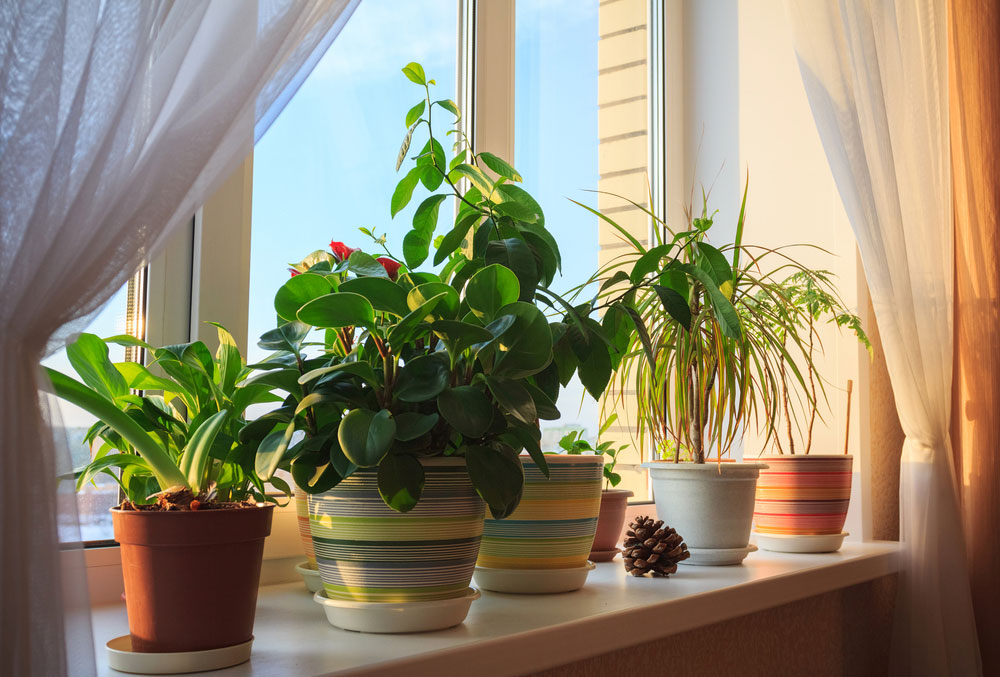Did you know that yesterday, January 10th, was House Plant Appreciation Day? In the middle of winter, I sure do appreciate mine.
If you’re like me, you’re tired of chilly gray winter days so you’d love to take home yet another plant to brighten a corner, a table, a windowsill. But there are some things to consider first.
Things to Think About Before You Take a New Houseplant Home
- Take a look at the place you want to put a new plant—and check out how much sunlight it gets. There are plants that love sunlight—and plants that love indirect light—but if you put a high-light plant in a low-light spot (or vice-versa) your plant won’t be happy—and that means YOU won’t be happy either. Also, think about how much light the area really gets. If you have a window that is so sunny that you keep the blinds closed, then it’s not really a sunny window…
- Know how to water a particular plant before it goes home with you. Remember, some plants—like cacti and succulents—are native to desert environments and will not need watering every week. As a matter of fact, they will likely resent watering every week. As a very general rule of thumb, most plants would prefer to dry out about halfway down into the soil before watering—just don’t let them go so dry they wilt. Cacti and succulents, on the other hand, can—and should–go just about totally dry before watering.
- Think about the mature size of the plant. If you want a cute little plant to sit on your desk, then don’t get a plant that has a mature height of five or six feet! If you want a big plant to sit in front of sliding glass doors, don’t buy a plant that maxes out at 18 inches.
- Consider any pets you have and check the toxicity of any plants you bring home. Some plants are toxic to pets. Go to ASPCA.com for lists of both toxic and non-toxic plants. When in any doubt, call a vet immediately.
- Pay attention to where heating vents are in relation to your new plant. Heated air is very drying so you don’t want it blowing directly on a plant. Most hardware stores carry “deflectors” which direct the air out into the center of the room.
- Don’t repot a new plant as soon as you get it home. It’s a big shock to take a new plant home. Repotting is another big shock. Try not to give a plant more than one shock at a time.
When in doubt, ask us—that’s what we’re here for!
To read more posts from Bonnie, visit our blog


I need help – I have a Myers Lemon tree have had it for years and produces a lot of lemons. Last year it got Mealy Bug (I think – looks like pieces of cotton). Fought it all winter with with Garden Safe Houseplant and Garden insect killer. Put it outside in spring and trimmed back and looked good all summer sprayed occasionally with Seven. Now I’m seeing more mealy bug. Why can’t I get rid of it – I’ve treated the dirt with insect killer thinking that would help. I’m about ready to call it quits. Thanks for any help.
Lois, unfortunately citrus are prone to mealybug and scale. Before you bring it in in the fall, give your Meyer Lemon a good spray with a horticultural oil. I will sometimes scrape off the top 1/2 inch of soil and replace it, just in case any eggs drop. Because we inevitably miss a few eggs when we spray I expect I will have to spray at least a couple more times once I bring it in. When you do spray, be sure to get the undersides of the leaves since that’s where many of them hide. I prefer a horticultural oil to other products. Seems to give me better results–and I don’t have to worry about chemical residue…
Thank you.
Lois, scale and/or mealybugs do seem to really have a preference for citrus but I am able to treat it successfully–and the little bit of trouble is worth it when I drink my iced or hot tea with my OWN home-grown lemon squeezed in there!
Thank you and yes it is but this stuff is really hard to control – to keep it sprayed I have to cover book shelves, desk, floor etc just to keep spray off. Really hard.
Lois, you can drag them outside on days when it’s 58 or warmer to spray. Still, they’re worth it.